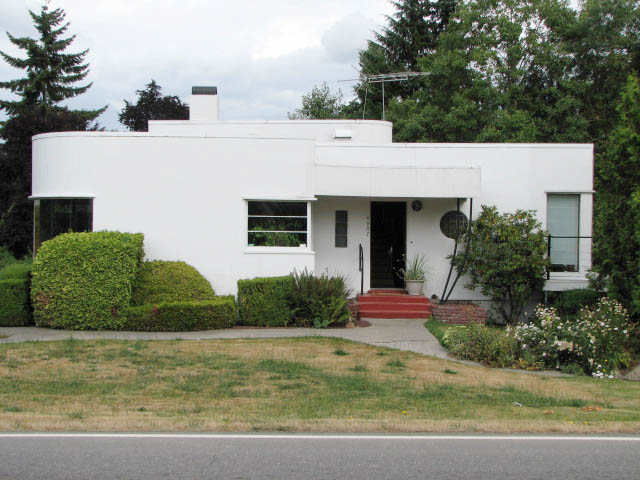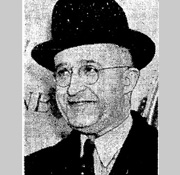Bert Smyser (1893–1987) was a designer and sometimes-architect based in the Tacoma. He is known to have worked on at least five building designs but was better known as a window dresser and exposition display designer. Some career highlights include his work on Washington State displays at the 1933 Chicago Century of Progress Exposition and the New York and San Francisco 1939 World’s Fairs.
Perhaps his best known work is the Coffee Pot Restaurant / Bob’s Java Jive, which is listed in the National Register of Historic Places and is a City of Tacoma Landmark. He designed five known buildings, 15 known window and showroom displays, seven known parade floats, and nine known exposition and fair displays.
Bert Allen Smyser was born on June 11, 1893, in New Brunswick, New Jersey, to Charles Smyser (1869– 1950) and Emma (nee Snyder, 1868–1942), but by 1897 the family had moved to Tacoma (“Bert” was his legal name; it is not a nickname). In 1909 at the age of 16, Smyser began his career at the Kennedy Brothers Arcade, a department/clothing store, in downtown Tacoma. In a 1974 interview, he said he walked into the building and asked for a job as a window dresser, even offering to work for free. By the following year, he was employed as a window dresser at the Stone-Fisher Company, a Tacoma-based dry goods department store. He designed a number of windows for the company and as early as 1911 was winning prizes for his displays. He also chaired several committees that helped coordinate window designs throughout Tacoma, including the local committee of the Federal Committee on Public Information, part of World War I war efforts.
In the 1920s, Smyser went into business for himself and founded Smyser Display Service. The company took on a number of projects, including window and showroom displays for clothing and automobile sales; parade floats in Washington and Oregon; and the Washington State displays for the 1933 Chicago Century of Progress Exposition and the 1939 San Francisco and New York World’s Fairs. The 1939 displays were elaborate and included large interactive dioramas and maps showcasing the state’s natural and built environments. Smyser reused some of the elements from the 1933 and 1939 fairs in his later designs, including commercial store redesigns, a Washington State Historical Museum exhibit, and in one of his own buildings. He was expected to design the American pavilion for the 1942 World’s Fair in Rome as well, but the fair was canceled due to World War II.
 Smyser’s first architectural design was the Coffee Pot Restaurant, today known as Bob’s Java Jive, in 1930. Shaped like a coffee pot, it is the only one of his buildings not designed in the Streamline Moderne style; his other four buildings are all designed in the style. The 1933 Century of Progress Exposition is credited with introducing the Streamline Moderne style to the general public, and it appears this was also Smyser’s introduction. His work (primarily displays) prior to 1933 is less modernistic, but many of his designs after are Streamline Moderne. His other architectural projects include a workshop for his company (ca.1934, Tacoma, demolished), the Century Ballroom (1934, Fife, demolished), the New Exposition Hall (1940, Tacoma), and his own residence, known as “The House of Tomorrow” (1941, Puyallup, demolished 2023). Smyser regularly credited his second wife, Helen (ca.1898–1981), as his co-designer, and considered them both architects on several of his projects, most notably the House of Tomorrow.
Smyser’s first architectural design was the Coffee Pot Restaurant, today known as Bob’s Java Jive, in 1930. Shaped like a coffee pot, it is the only one of his buildings not designed in the Streamline Moderne style; his other four buildings are all designed in the style. The 1933 Century of Progress Exposition is credited with introducing the Streamline Moderne style to the general public, and it appears this was also Smyser’s introduction. His work (primarily displays) prior to 1933 is less modernistic, but many of his designs after are Streamline Moderne. His other architectural projects include a workshop for his company (ca.1934, Tacoma, demolished), the Century Ballroom (1934, Fife, demolished), the New Exposition Hall (1940, Tacoma), and his own residence, known as “The House of Tomorrow” (1941, Puyallup, demolished 2023). Smyser regularly credited his second wife, Helen (ca.1898–1981), as his co-designer, and considered them both architects on several of his projects, most notably the House of Tomorrow.
Bert Smyser was convicted of tax fraud in 1954, which effectively put an end to his design commissions. He converted his workshop on South Tacoma Way to a motel – in which he installed elements from the 1933 and 1939 world’s fairs – but continued to develop designs, although none were built. Two of these were his imaginings for a tower and “aerial-rail suspended rapid transit system” for the 1962 Seattle World’s Fair. Even these later drawings have a Streamline Moderne sensibility with rounded corners and no decorations. His near life-long aversion to square corners gained him the nickname “Bullnose” among his friends.
Bert Smyser married his first wife, Velma Anderson, in 1914, and they had two children, Allen and Arlene. Allen worked with his father at Smyser Display Service and served in the Navy during WWII. Arlene had scoliosis that necessitated surgery, and she died from complications at age 16 in 1934. Bert and Velma divorced in 1940; less than a month later, he married his second wife, Helen. Together they designed the “House of Tomorrow” and lived there until their deaths. Helen died in 1981 at the age of 80, and Smyser died at 93 in 1987.
This profile of Bert Smyser was provided by Pierce County as part of its Clarks Creek Property Acquisition project, which was funded by Pierce County and the Flood Mitigation Assistance grant from Federal Emergency Management Agency and Washington Emergency Management Division. (CFDA # 97.029 [Flood Mitigation Assistance]). This article does not constitute an endorsement by FEMA or reflect FEMA’s views. Learn more about the project at PierceCountyWa.gov/ClarksCreekAcq.





